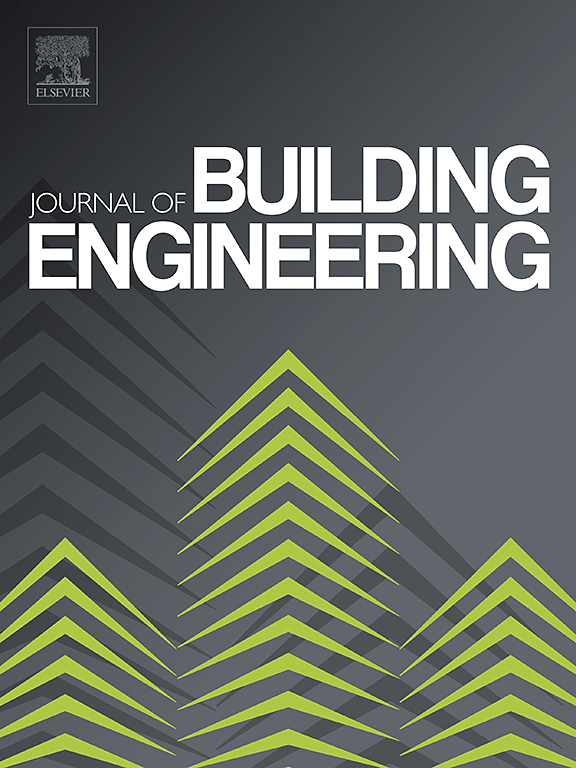Composition optimization of cement-gypsum based silica aerogel with low thermal conductivity insulation mortar
IF 6.7
2区 工程技术
Q1 CONSTRUCTION & BUILDING TECHNOLOGY
引用次数: 0
Abstract
Although the thermal conductivity of mortar can be effectively reduced by adding appropriate amount of SiO2 aerogel to the inorganic cementitious material matrix, the thermal conductivity of thermal insulation mortar is still different from that of organic thermal insulation materials. Therefore, in order to further reduce the thermal conductivity, this paper optimized the composition and formula of cement gypsum silica aerogel thermal insulation mortar. To explore the influence of the amount of polystyrene particles (EPS) (3.9 kg/m3, 5.2 kg/m3, 6.5 kg/m3), the amount of aerogel instead of gypsum (30 wt%, 40 wt%, 50 wt%) and the silica fume ratio of mineral powder (4:1, 1:1, 1:4) on the thermal conductivity, density and compressive strength of mortar. By using X-ray diffraction, scanning electron microscopy, and nuclear magnetic resonance analysis, the mineral composition, microstructure, and pore size distribution of mortar were studied to clarify the correlation between the microstructure of insulation mortar and its insulation performance. The results show that: The influence degree of the above three factors on thermal conductivity and compressive strength of thermal insulation mortar specimens is ranked as follows: silica fume ratio of mineral powder EPS particle content aerogel content. The order of influence degree on density is: EPS particle content silica fume ratio of mineral powder aerogel content. When the EPS particle content is 5.2 kg/m3, the aerogel content is 30 wt%, and the ratio of mineral powder to silica fume is 4:1, the thermal conductivity of the thermal insulation mortar specimen is 0.032 W/(m∙k), the density is 0.18 g/cm3, and the compressive strength is 0.09 MPa. Changing the composition parameters of the mortar do not alter the mineral composition of the insulation mortar specimens, only the degree of hydration. As the thermal conductivity of mortar decreases, the volume of macropores inside the mortar gradually decreases (decreasing by 13.9 % and 33.2 % respectively), while the volume of transition pores and capillary pores gradually increases (increasing by 6.7 %、29.4 % and 2.6 %、4.6 % respectively).
虽然在无机胶凝材料基体中加入适量的二氧化硅气凝胶可以有效降低砂浆的导热系数,但保温砂浆的导热系数与有机保温材料的导热系数仍有差异。因此,为了进一步降低导热系数,本文对水泥石膏硅气凝胶保温砂浆的组成和配方进行了优化。探讨聚苯乙烯颗粒(EPS)用量(3.9 kg/m3、5.2 kg/m3、6.5 kg/m3)、气凝胶代替石膏的用量(30 wt%、40 wt%、50 wt%)以及矿粉硅灰比(4:1、1:1、1:4)对砂浆导热系数、密度和抗压强度的影响。通过 X 射线衍射、扫描电子显微镜和核磁共振分析,研究了砂浆的矿物成分、微观结构和孔径分布,以明确保温砂浆的微观结构与其保温性能之间的相关性。结果表明上述三个因素对保温砂浆试件导热系数和抗压强度的影响程度依次为:矿粉硅灰比> EPS颗粒含量> 气凝胶含量。对密度的影响程度排序为EPS颗粒含量> 矿粉硅灰比> 气凝胶含量。当 EPS 颗粒含量为 5.2 kg/m3,气凝胶含量为 30 wt%,矿粉与硅灰比为 4:1 时,保温砂浆试样的导热系数为 0.032 W/(m∙k),密度为 0.18 g/cm3,抗压强度为 0.09 MPa。改变砂浆的成分参数不会改变保温砂浆试样的矿物成分,只会改变水化程度。随着砂浆导热系数的降低,砂浆内部的大孔隙体积逐渐减少(分别减少了 13.9 % 和 33.2 %),而过渡孔隙和毛细管孔隙的体积逐渐增加(分别增加了 6.7 %、29.4 % 和 2.6 %、4.6 %)。
本文章由计算机程序翻译,如有差异,请以英文原文为准。
求助全文
约1分钟内获得全文
求助全文
来源期刊

Journal of building engineering
Engineering-Civil and Structural Engineering
CiteScore
10.00
自引率
12.50%
发文量
1901
审稿时长
35 days
期刊介绍:
The Journal of Building Engineering is an interdisciplinary journal that covers all aspects of science and technology concerned with the whole life cycle of the built environment; from the design phase through to construction, operation, performance, maintenance and its deterioration.
 求助内容:
求助内容: 应助结果提醒方式:
应助结果提醒方式:


